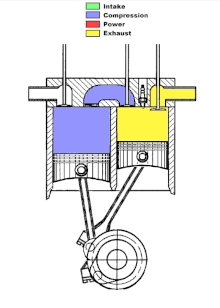Scuderi engine
The Scuderi split-cycle engine is a four-stroke engine that is currently being developed , which works according to the split engine principle with spatially separated stroke cycles. It was named after its inventor, Carmelo J. Scuderi.
history
The split principle was originally developed as a two-stroke engine . A well-known variant is the Puch two-stroke twin-piston engine designed by Giovanni Marcellino for the Puch factory .
From 2001, the Scuderi Group from West Springfield (Massachusetts) developed the Scuderi engine together with automotive suppliers such as Bosch Engineering and Mahle as well as the Southwest Research Institute . The company has financed research and development of the first split-cycle naturally aspirated engine since 2008, initially from its own resources.
From 1994 until his death in 2002, Carmelo Scuderi worked on optimizing the internal combustion engine. By July 2009, US $ 35 million had been invested in the project. A 1 liter prototype with two pairs of cylinders was presented to the Society of Automotive Engineers at the SAE World Congress in Detroit in April 2009 . Further expansion stages and improvements are planned.
advantages
According to the company, the Scuderi engine should be characterized by more consistent combustion, higher efficiency , lower pollutant emissions and higher torque .
The Scuderi engine with compressed air storage is also practically equivalent to a compressor engine with little charge air cooling . A higher output can be achieved per cylinder volume than in conventional two-stroke gasoline engines, since more air mass can get into the combustion cylinder through the pre-charging. Conversely, it would be possible to reduce the displacement and the friction with the same performance. It was calculated that the Scuderi engine in a mid-range car should consume 25 percent less fuel than conventional gasoline engines, and as a compressed air hybrid engine even 30 to 36 percent less.
In the next expansion stage, the Scuderi engine is to be equipped with a turbocharger, which should contribute to a further increase in torque and efficiency.
disadvantage
- Practically every gasoline engine or diesel engine can be ignited after top dead center (TDC). Ignition after TDC is always a loss of efficiency (see constant space and constant pressure process ).
- The exhaust gas temperature can rise. The efficiency of a heat engine is determined by the maximum temperature after combustion (after top dead center) and the minimum temperature at the end of the gas expansion or work process (at bottom dead center).
- The working cylinder is subjected to higher thermal loads. There may be problems with the hot cylinder and the thermal stress between the hot and cold cylinders.
- The air transfer pipes can generate considerable flow and friction losses and thus reduce the pre-charging of the working cylinders.
- Compression and decompression of air as an energy storage process achieves only low efficiencies and would be z. B. inferior to the electric hybrid system. It is questioned whether the compressed air hybrid with the limited air storage capacity and the additional motor parts and the losses in energy conversion can achieve a significant increase in efficiency.
The Scuderi Group states that the technical concerns have been debunked, the problems have been resolved and the reliability has been ensured through numerous patented developments, but no well-known publications or other scientifically exact and verifiable statements are known about this engine.
Web links
Individual evidence
- ↑ Automobilwoche of January 19, 2011 http://www.automobilwoche.de/article/20110119/REPOSITORY/110119941/
- ↑ FAZ of February 5, 2011, RheinMainMarkt, page 9: Italo-Americans as savings miracles
- ↑ AutomobilKONSTRUKTION, Edition 2011/001 Archived copy ( Memento of the original from March 4, 2016 in the Internet Archive ) Info: The archive link was inserted automatically and has not yet been checked. Please check the original and archive link according to the instructions and then remove this notice.
